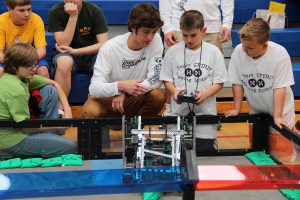When tasked with the assignment of creating a blog that deals with a Technology Issue, I immediately thought of classroom distractions, privacy, safety, cost, and lack of stakeholder support. However, as I researched further there were connections among concepts, which were interesting to me.
A large issue surrounding the integration of technology into the classroom is certainly teacher training because the implementation and achievement of student skills ultimately rests with the teacher. “As leaders, it is important to look at these skills and equip teachers with as much support as possible in order for them to succeed in this endeavor” (Garland, Tadeja 2013). On another note, some teachers may feel that technology integration will diminish student-teacher interaction, which in turn affects face-to-face communication for the 21st century marketplace. These two ideas led me to a solution, which is centered on student engagement.
That being said, effectively engaging students will require proper teacher training and a dynamic classroom environment that will foster technology integration, collaboration, teacher support, and much more. Take a look at the photo below where students are participating in a STEM project, they are engaged, actively learning, and had a teacher sponsor to support their discover

With teacher training and relationship building, there is much potential for a positive classroom community to be created. In order to do so effectively, students must feel valued and heard. They must feel as though they are challenged enough, but not placed in a realm of education that is “unattainable” for them. Students would be less likely to “give up” or ignoring the information being presented to them. This differentiation of education through technology integration is great! There are so many ways in which incorporating technology such as iPad, Smartboards, Twitter, and etc. will excite and promote engagement ultimately increasing student engagement and differentiation of instruction.
Below is a hyperlink to a prezi presentation created by Tashi Lockett and Jeanigh Jean-Baptiste, which shares some techniques that can be used to enhance student engagement within the classroom. Some ways presented are exploratory learning, peer collaboration, role playing, and higher order questioning.
https://prezi.com/zkhkhi61fusu/student-engagement-techniques-for-the-21st-century-learner/
As you explored the prezi, it is important to realize that within the multiple ways of engagement, a teachers role is to act as a facilitator and in doing so student-teacher interactions should actually increase. Students will feel as though they are in a safe environment to share their thoughts and ideas without judgement. In relation, Karen Wilkens who is an online business trainer and PhD student researching the effect of technology on relationships believes, “many writers who look at Computer Mediated Communication (CMC) feel that the ‘power’ relationship between student and teacher is being eroded and that the internet is creating an equal and more anonymous relationship” (Wilkens 2014).
In the prezi presentation there is a news broadcast film embedded. Here an educator is seen placing emphasis on the fact that during technology integration students are constantly problem solving, critical thinking, and discovering answers on their own. She believes that this makes students more interested in their learning as they personalize their educational endeavors.
Engaged learning can be assessed through the presentation of authentic tasks, projects, or investigations, observation, investigation, and much more (Jean-baptiste, Lockett 2014). Based on technology integration, any assessment MUST be done by allowing students an opportunity to apply what they know. Traditional forms of assessment should be avoided in order to support active and stimulating learning along the way.
After much research and analysis, I believe technology integration is a “game changer” for education and will continue to be so. Therefore, it is evermore important to properly train educators on how to use technology effectively. Once trained and implementation is in effect, teacher-student relationships will progress allowing for enhanced student engagement. It is clear that this all starts with the educational institution and teachers because they have a wonderful opportunity to positively prepare students for the 21st century global marketplace through the integration of technology.
“The most effective leaders are outstanding communicators with a high level of social intelligence; their capacity to connect people with other people, using technologies to collaborate and leveraging data to support their ideas, requires an ability to understand the bigger picture and to make appeals that are based on logic, data, and instinct” (NMC 2014).

Works Cited:
Garland, V. E., & Tadeja, C. (2013). Educational leadership and technology: Preparing school administrators for a digital age. New York: Routledge.
Jean-baptiste, J., & Lockett, T. (2014, December 5). Student engagement techniques for the 21st century learner. Retrieved July 07, 2016, from https://prezi.com/zkhkhi61fusu/student-engagement-techniques-for-the-21st-century-learner/
NMC. (2014). NMC Horizon Report: 2014 K – 12 Edition Preview. Retrieved July 07, 2016, from http://cdn.nmc.org/media/2014-horizon-k12-preview.pdf
Wilkens, K. (2014, May). How new technologies affect student-teacher relationships. Retrieved July 06, 2016, from https://www.britishcouncil.org/voices-magazine/new-technologies-affect-student-teacher-relationships

